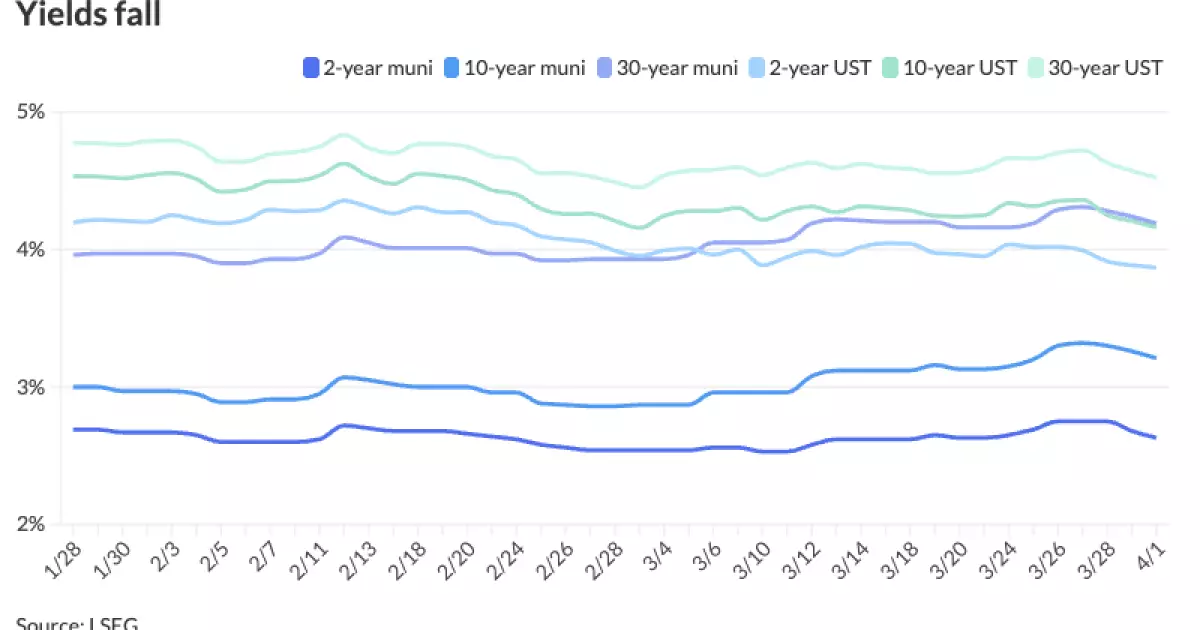7 Shocking Trends in Municipal Bonds You Must Know

In the world of municipal bonds, the air of uncertainty is almost palpable as looming tariffs and fluctuating Treasury yields tighten their grip on the market. As the Trump administration’s tariff decisions draw near, municipal bonds appear to be trapped in a vice between rising supply and dwindling demand. It is critical to navigate this terrain carefully, as investors make choices that can either bolster or hinder their portfolios.
Unequivocally, the ratio of yields on municipal bonds to U.S. Treasuries reveals striking statistics: a mere 68% for two-year bonds and a daunting 93% on the 30-year bonds. Such numbers indicate a phenomenon that seasoned market participants should watch closely. According to municipal portfolio manager Daryl Clements, the decline in yield ratios hints at a market ripe for rallying. After all, when munis appear too cheap in comparison to Treasuries, they tend to bounce back. Yet, the question remains: How long will investors wait before acting?
Market Technicals and Potential Volatility
Year-over-year supply has surged by an astonishing 14.5%, while the demand has remained negative for a staggering three weeks. These dynamics paint a picture of a market under pressure, caught between a high influx of new bonds and investor hesitance amidst stringent economic conditions and policy changes. It’s a complex dance, and only those with a keen understanding of market signals are equipped to thrive.
For the week ahead, volatility looms like a dark cloud over the market. Not only are tariff implementations potentially looming, but key economic indicators such as nonfarm payroll releases promise to stir the pot. J.P. Morgan strategists foresee an uptick in market stability due to improved relative value conditions and the anticipated inflow of capital in April. Investors would be wise to tread carefully, as the estimated $9.3 billion in supply could challenge even the most optimistic projections.
The upcoming April coupon payments present an opportunity for stabilization; however, experts like Pat Luby highlight an alarming forecast for redemptions—projecting the lowest levels of the year. The reinvestment phenomena are not far on the horizon, yet they seem muted compared to previous years, leading to a rather tepid outlook for municipal bond growth.
Interest Rates: The Uncertain Future
With benchmark AAA MMD yields experiencing declines of five to 12 basis points, we find ourselves reflecting on the implications for fixed-income investors. These adjustments indicate a sensitive response to market fluctuations, and indeed, rates can be both a weapon and a shield. Investors must grapple with timing and the potential for rising rates that can significantly impact their returns.
The primary market sees a defendant race of issuers vying for investors’ attention. Recently, one single issuance from California saw initial tranches yield between 2.84% and 4.50%. In stark contrast, the Chicago-based Illinois Finance Authority offered rates starting at 2.67%. Such disparities encapsulate the current climate of yielding anxieties, where high-quality investments compete for limited capital amid broader market volatility.
Amidst all these uncertainties, what we must not overlook is the critical intersection between macroeconomic trends and micro-level investor behavior. As the world edges closer to another round of past financial calamity, the distinction between sound investment and financial folly becomes more pronounced.
The Shift in Investor Sentiment
The municipal bond market’s landscape is also reflective of evolving investor sentiment. As equity markets fluctuate, savvy investors are leaning towards the relative safety of municipal bonds. But how long can this trend endure? Investing in munis requires a stark assessment of risk versus reward and the weighing of current yield spread dynamics.
The overwhelming pressure of added supply meets the fearful investor with a rising tide of caution. As technical indicators suggest a potential rally, the question remains whether investor sentiment can regain its footing and translate into actionable investment decisions. History has shown that fear can often paralyze decision-making, prompting missed opportunities during potential upswings.
With a complex variety of factors at play—including global trade tensions and internal economic policies—the path ahead is fraught with challenges. Investors must harness patience while maintaining a keenness for opportunities with robust analysis and a forward-thinking approach. In these uncertain times, the savvy investor—a rare breed—will not merely react but instead adapt with precision.
By embracing a center-right liberal perspective, we acknowledge the importance of both prudent fiscal responsibility and a competitive marketplace capable of fostering investment growth. The approach should not only encourage diversified portfolios but also strengthen consumer trust in municipal bonds as vested interests align more closely with sustainable economic practices.





